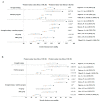Role of Nutrition and Exercise Programs in Reducing Blood Pressure: A Systematic Review
- PMID: 31492032
- PMCID: PMC6780911
- DOI: 10.3390/jcm8091393
Role of Nutrition and Exercise Programs in Reducing Blood Pressure: A Systematic Review
Abstract
The combined effect of diet and strength training (ST) on blood pressure (BP) seems to be very important for the treatment of prehypertension and hypertension (HT). Therefore, the aim of this study was to determine whether ST alone or combined with nutrition or supplementation has an impact on the arterial pressure reduction in normotensive and hypertensive populations. A systematic computerized literature search was performed according to the PRISMA guidelines using PubMed, Scopus and Google Scholar; only English language studies published from 1999 until 2018 were included. This systematic search identified the results of 303 individuals from nine studies. The ST program alone had a similar effectiveness as the nutrition program (NP) alone; however, their combination did not result in increased effectiveness in terms of a high BP reduction. The consumption of L-citrulline had a similar effect as ST on lowering BP; on the other hand, caffeine led to an increase in BP during the ST session. Our data suggest that a combination of ST 2-3 times a week at moderate intensity and a NP seems to be equally effective in terms of lowering BP (systolic and diastolic) as ST and NP alone.
Keywords: arterial pressure; caffeine; disease prevention; hypertension; resistance training.
Conflict of interest statement
The authors declare no conflict of interest.
Figures



Similar articles
-
The effectiveness of exercise training in lowering blood pressure: a meta-analysis of randomised controlled trials of 4 weeks or longer.J Hum Hypertens. 1997 Oct;11(10):641-9. doi: 10.1038/sj.jhh.1000509. J Hum Hypertens. 1997. PMID: 9400906
-
Sex May Modulate the Effects of Combined Polyphenol Extract and L-citrulline Supplementation on Ambulatory Blood Pressure in Adults with Prehypertension: A Randomized Controlled Trial.Nutrients. 2021 Jan 27;13(2):399. doi: 10.3390/nu13020399. Nutrients. 2021. PMID: 33513929 Free PMC article. Clinical Trial.
-
Nonpharmacologic Interventions for Reducing Blood Pressure in Adults With Prehypertension to Established Hypertension.J Am Heart Assoc. 2020 Oct 20;9(19):e016804. doi: 10.1161/JAHA.120.016804. Epub 2020 Sep 25. J Am Heart Assoc. 2020. PMID: 32975166 Free PMC article.
-
Changes in blood pressure among users of lay health worker or volunteer operated community-based blood pressure programs over time: a systematic review protocol.JBI Database System Rev Implement Rep. 2015 Oct;13(10):30-40. doi: 10.11124/jbisrir-2015-1927. JBI Database System Rev Implement Rep. 2015. PMID: 26571280
-
Is Low-Intensity Isometric Handgrip Exercise an Efficient Alternative in Lifestyle Blood Pressure Management? A Systematic Review.Sports Health. 2020 Sep/Oct;12(5):470-477. doi: 10.1177/1941738120943882. Epub 2020 Aug 10. Sports Health. 2020. PMID: 32776866 Free PMC article.
Cited by
-
Determinants of self-reported hypertension among women in South Africa: evidence from the population-based survey.Clin Hypertens. 2022 Nov 15;28(1):39. doi: 10.1186/s40885-022-00222-5. Clin Hypertens. 2022. PMID: 36376985 Free PMC article.
-
Association of triglyceride glucose index and its combination of obesity indices with prehypertension in lean individuals: A cross-sectional study of Chinese adults.J Clin Hypertens (Greenwich). 2020 Jun;22(6):1025-1032. doi: 10.1111/jch.13878. Epub 2020 May 22. J Clin Hypertens (Greenwich). 2020. PMID: 32442359 Free PMC article.
-
Effect of an Acute Resistance Training Bout and Long-Term Resistance Training Program on Arterial Stiffness: A Systematic Review and Meta-Analysis.J Clin Med. 2021 Aug 7;10(16):3492. doi: 10.3390/jcm10163492. J Clin Med. 2021. PMID: 34441788 Free PMC article. Review.
-
Special Issue on Clinical Medicine for Healthcare and Sustainability.J Clin Med. 2020 Jul 13;9(7):2206. doi: 10.3390/jcm9072206. J Clin Med. 2020. PMID: 32668562 Free PMC article.
-
Changes of abdominal wall tension across various resistance exercises during maximal and submaximal loads in healthy adults: a cross-sectional study.BMC Sports Sci Med Rehabil. 2025 May 5;17(1):114. doi: 10.1186/s13102-025-01161-y. BMC Sports Sci Med Rehabil. 2025. PMID: 40325422 Free PMC article.
References
-
- Pickering T.G., Hall J.E., Appel L.J., Falkner B.E., Graves J.W., Hill M.N., Jones D.W., Kurtz T., Sheps S.G., Roccella E.J. Recommendations for blood pressure measurement in humans: An AHA scientific statement from the council on high blood pressure research professional and public education subcommittee. J. Clin. Hypertens. 2005;7:102–109. doi: 10.1111/j.1524-6175.2005.04377.x. - DOI - PMC - PubMed
-
- Chobanian A.V., Bakris G.L., Black H.R., Cushman W.C., Green L.A., Izzo J.L., Jr., Jones D.W., Materson B.J., Oparil S., Wright J.T., Jr., et al. Seventh Report of the Joint National Committee on Prevention, Detection, Evaluation, and Treatment of High Blood Pressure. Hypertension. 2003;42:1206–1252. doi: 10.1161/01.HYP.0000107251.49515.c2. - DOI - PubMed
-
- Meyer K. Resistance exercise in chronic heart failure—Landmark studies and implications for practice. Clin. Investig. Med. 2006;29:166–169. - PubMed
Publication types
Grants and funding
LinkOut - more resources
Full Text Sources
Miscellaneous

